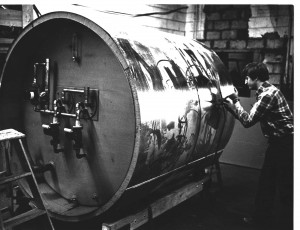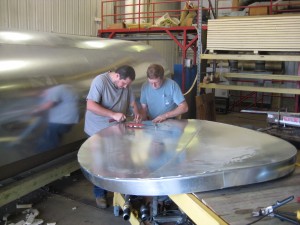Like Father, Like Son…
This is a picture of Danny Pleasant putting sheet metal on a 1000 gallon tank for a commercial job, circa 1982.

Danny, 1982
The second picture is Danny and his son, Brian, building sheet metal for a 2500 gallon tank going to the WTU in 2010.

Like father, like son.

Hello Dr. Ben,
I’m Dutch male, 46 years and living In Spain. I recently moved to Spain to start my business in selling and installing solar hot water installations for private houses in our area. I’m a technician but have little experience in solar.
Surfing the net internet for information I found your site. I appriciate that you share your knowledge with others.
I do have lots of questions but understand that I can not overload you with them.
One question I want to ask you: do you know a good and recent book about solar hot water heating?
I also want to tell you a littlebit about my next and first project: a solar hot water installation in our house.
I want to design a system for hot water for 4 persons, with supporting the central heating (gas) and heating the swimmingpool in summer (april till october). The idea is to use all the excess heat in summer for the pool.
In winter I want to support the central heating but I do not know what type of boiler I need. Can you give me advice about that.
Thank you.
Kind regards,
Stefan Martens
Stefan,
We have a dilemma. All the things you want to do are contained in my installation manual written in the ’80s for residential products. However, it doesn’t teach how to size systems, and the manual refers to the specific products I manufactured for residential applications.
However, those products are not available because I had to close the factory in the ’80s due to lack of business in the USA.
Now, 20 years later we are starting a new factory, but concentrating on commercial size systems, not residential. That will take longer, and getting products into Europe is a major effort that will take some time.
So, the short answer is that all the things you want to do have been done in the USA many times, but I don’t know any way to help you get the products to do them in Europe.
As a start, you need to know the heating requirement for each month of the year. You also need to know the available solar radiation for each month of the year. These numbers are entered into a computer program, along with solar collector and storage size numbers to determine how much solar to use and the energy produced by that system.
Once the energy loads and system sizing are done, then you need to design the hardware system to do all the tasks.
I design only drain back systems, which have fewer components and are more efficient than antifreeze systems. They also last longer.
Since you say you are just starting out in the solar business, I recommend you install a few simple domestic hot water systems to get some experience before tackling all the options you mentioned.
On the other hand, if you love to tinker and you don’t care if the system works very well, then you can try all the options you mentioned.
If you really want to proceed, consider the storage tank as the hub of all the applications. Heat goes in from the collectors; heat goes out to space heating, domestic hot water, and pool heating. Each circuit is independently controlled.
Since solar is only a supplement to heating, you have to have conventional water and space heating systems installed. The solar system then assists the conventional systems to save fuel costs.
I hope this helps.
Dr. Ben
Hello Dr. Ben,
Thank you for the feedback. After reading more on your website and about drainback systems I’m convinced that drainback is the best solution for a hot climate as we have here in Spain.
In Europe drainback is not used very much yet and only few manufactures have systems.
But I found a good German manufacturer in Wagner & Co and their EASYsol and SECUsol drainback systems for hot water.
Because I also want to support heating I have to design a system myself, using proven components.
One thing I do not understand is the drain from the collector. How can it empty completely?
In a drainback system do you always have to place the collector above the tank?
Thank you for your time and help.
Kind regards,
Stefan Martens
“One thing I do not understand is the drain from the collector. How can it empty completely?”
As long as the drainage slope is maintained without any traps in the piping, the water will always empty back into the tank.
“In a drainback system do you always have to place the collector above the tank?”
Yes.
Dr. Ben
Hi Dr. Ben,
I applaud your early pioneering efforts with SHW. I think your market has finally arrived for residential use. The California Energy Commission has an incentive plan in place again. What you need is venture funding to roll out a home system.
Please think about that.
Good Luck,
-Steve